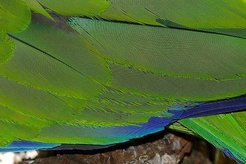Marie Skłodowska-Curie Actions Fellowship for Hope Bretscher
Hope Bretscher from the Ultrafast Transport in Quantum Materials research group has been selected for a Marie Skłodowska-Curie Actions Fellowship to investigate the behavior of electrons in materials made up of stacked layers that are each just a few atoms thick. She is developing a new research technique to investigate how the individual layers influence each other’s electronic properties and those of the material as a whole.
The ultrathin materials of interest are crystalline solids, meaning that they are made up of atoms which are bonded together in very ordered, repeating patterns. When two layers of the same material are stacked on top of each other misaligned by a small angle, the structured arrays of atoms interfere with each other, generating a new so-called “moiré pattern.”

A similar effect can be seen if one looks closely at bird’s wings. Each individual feather is made up of parallel barbs. When the feathers overlap each other at specific angles, wavy or circular patterns appear. In the materials Bretscher is studying, this effect is not just a visual one. Intriguingly, the moiré patterns lead to significant and surprising changes in the way that the electrons behave. Depending on the twist angle between the layers, the stack can assume entirely new properties such as, for example, superconductivity, magnetism, or anomalous insulating states. Crucially, these states – some of which have never previously been observed – can be switched off and on by tweaking the number of electrons in the material. This approach holds vast potential for the design of innovative materials and technologies.
Scientists want to understand the relationship between the moiré patterns and the changes in electronic properties. Some of the observed behavior, the way that electrons move, could be useful for computation and information storage. At this point, most of the interesting phenomena in moiré structures occur at very low temperatures, too cold for any practical uses. However, a better understanding of when and why certain behaviors are observed could enable scientists to design materials that show similar effects at realistic temperatures for application.
“This research I find really exciting, as we try to take puzzle pieces from experimental techniques that may be well understood and developed in other fields, and put them together in new ways,” says Hope. “This will allow us to investigate these remarkable materials with an entirely different perspective, and with a high degree of control which is necessary to be able to understand these very complex systems.”
As a passionate communicator, she especially values the Fellowship’s significant emphasis on scientific communication and the dissemination of knowledge, both to other scientists and to the wider public. “It is really important to me that people can participate in science, understand the way research is carried out and benefit from its findings. Science is a public good and it is imperative to share it with people from scientific and non-scientific backgrounds all over the globe.”
Hope Bretscher will begin her Marie Skłodowska-Curie Postdoctoral Fellowship research next year. She joined the UTQM research group led by James McIver at the MPSD in 2021 after working as a graduate student researcher at the University of Cambridge for four years. Previously, she had completed her BA in Physics at the University of Chicago in 2015, followed by an MA in Science and Technology in Society at the University of Edinburgh.
The highly competitive Marie Skłodowska-Curie Postdoctoral Fellowship is awarded to excellent researchers to implement an original and personalized research project. In the most recent round, fellowships worth €242 million in total were awarded to 1,156 postdoctoral researchers. Applications for this year’s call need to be submitted by 14 September 2022.












